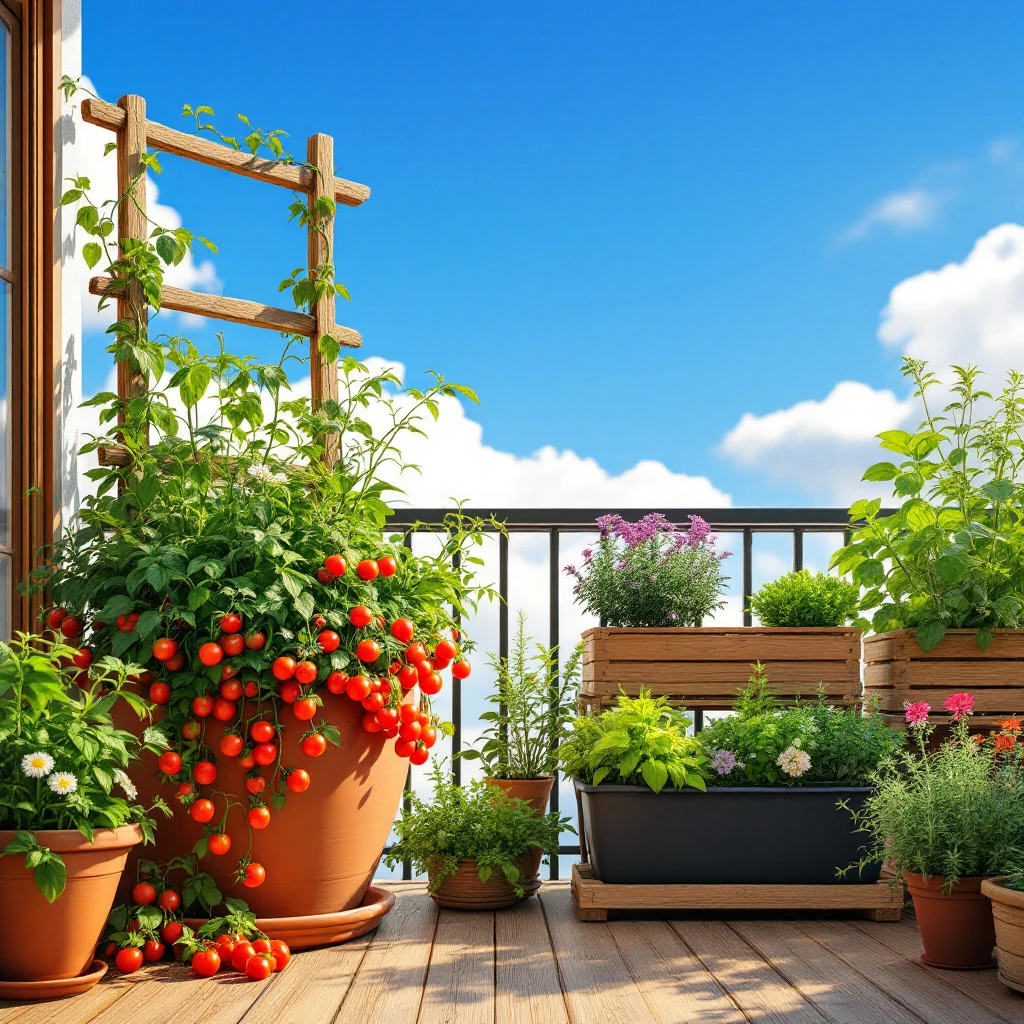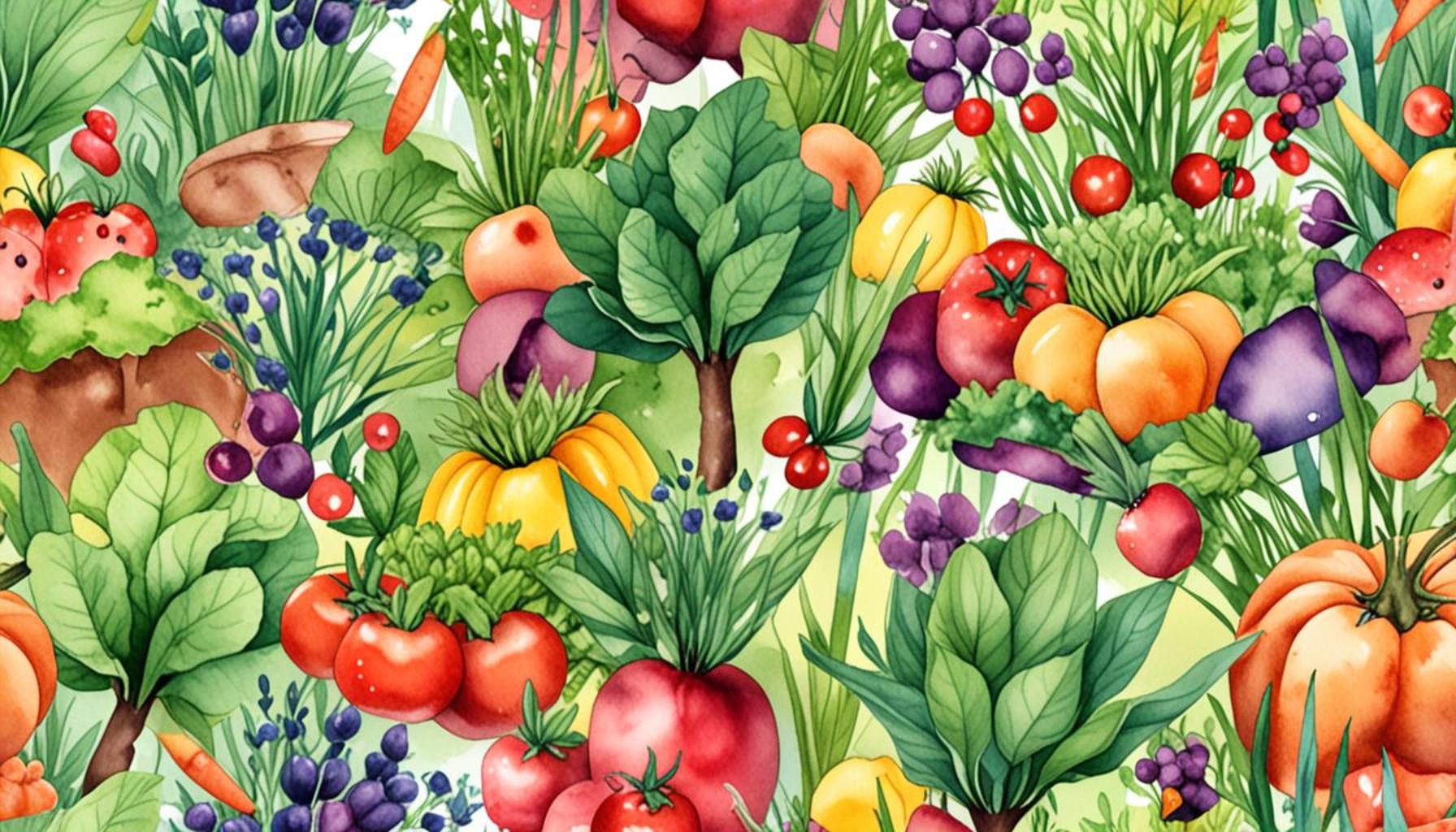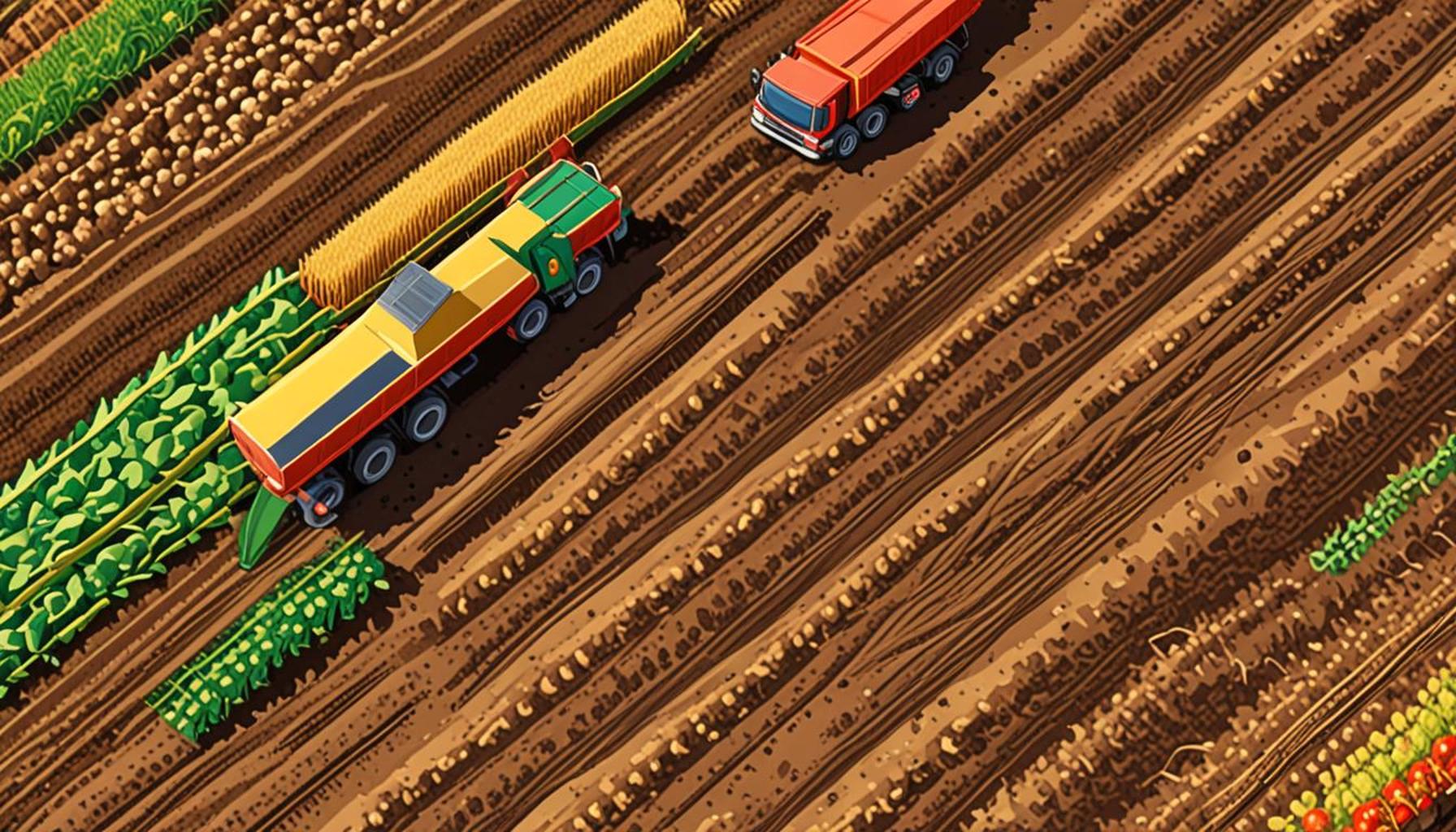Harvest in Small Spaces: Strategies for Urban Gardens and Balconies

Maximizing Your Green Thumb
Urban living often means limited space, but that doesn’t have to curtail your gardening dreams. With the right strategies, you can transform balconies and small backyards into lush urban gardens. Understanding how to maximize your available area is key to creating a vibrant and productive green space. Here are some key elements to consider:
- Vertical Gardening: This innovative technique involves utilizing walls, fences, and even trellises to grow your plants upward rather than outward. Vertical planters can dramatically increase your planting area without overtaking precious ground space. For instance, hanging planters filled with herbs or flowers can create a cascading effect that adds charm while maximizing space. Consider the use of vertical garden systems that can be mounted on railings or walls, allowing you to cultivate your garden even in the narrowest of spaces.
- Container Gardening: Embrace the versatility of pots, tubs, and repurposed items for planting. Almost anything can become a pot—a wooden crate, an old wheelbarrow, or even a sturdy tote bag. Container gardening offers excellent drainage and soil control, which is essential for healthy plant growth. You can select various sizes to suit your space, and when placed strategically on a balcony or patio, they create a charming, personalized garden area.
- Herb Gardens: Cultivating culinary favorites such as basil, parsley, and thyme can elevate not just your cooking but also the aesthetics of your living environment. These herbs are particularly well-suited for container gardening and can be grown indoors on a sunny windowsill or outdoors on a balcony. They require minimal space and maintenance, making them an excellent choice for busy urban dwellers.
Small spaces can yield surprisingly abundant harvests. By optimizing available areas, you can grow:
- Vegetables: Vegetables like tomatoes, peppers, and lettuce commonly thrive in compact settings. For example, cherry tomatoes grow well in pots and produce plentiful fruit, making them a favorite among urban gardeners.
- Fruits: Strawberries and dwarf fruit trees, such as potted lemon or lime trees, can flourish on balconies, offering a delightful taste of homegrown sweetness in a confined environment. These fruit-bearing plants often come in attractive containers that double as decor.
- Flowers: Edible flowers like nasturtiums and pansies not only enhance the beauty of your space but also add unique flavors to your culinary creations, making them an excellent choice for combining aesthetics and function.
Adopting these practices not only enhances your living environment but also promotes sustainability by reducing the carbon footprint associated with store-bought produce. Join the urban gardening movement and discover how you can achieve a bountiful harvest, even in limited space. Explore the tips and tricks that can make your urban garden a reality, from choosing the right soil mixtures to understanding local climate conditions. With a little creativity and dedication, you can create an oasis of greenery amidst the concrete jungles, contributing positively to both your well-being and the environment.
DISCOVER MORE: Click here to learn about selecting aromatic plants
Creative Strategies for Urban Gardening
With the growing trend of urban living, balancing limited space with the desire for greenery is now more relevant than ever. Small spaces such as balconies, patios, and even tiny backyards can be transformed into vibrant urban gardens. Key strategies are essential to maximize your gardening potential while making the most of every available square foot. Here’s how you can get started:

- Layering Your Plants: Utilizing the principle of layering in your plantings allows for more efficient use of vertical space. When you grow taller plants, such as sunflowers or pole beans, alongside shorter ones like lettuce or radishes, you create a multifaceted garden. This not only optimizes light exposure for each plant but also fosters a diverse ecosystem that can deter pests.
- Choose Compact Varieties: With a myriad of plant types available, opt for compact or dwarf varieties suited for container gardening. For instance, the ‘Patio Princess’ tomato absorbs far less room than standard tomatoes but still provides a robust yield. Similarly, heirloom varieties can thrive in small patches, offering both taste and beauty to your urban garden.
- Succession Planting: To maximize harvest throughout the growing season, consider succession planting. This technique involves sowing seeds at regular intervals; as one crop is harvested, another is ready to take its place. Start with fast-growing crops, such as radishes, followed by slower-growing options, like carrots, to ensure continual production and color in your garden.
Furthermore, the type of soil you choose plays a critical role in the success of your urban garden. Selecting high-quality potting soil, rich in nutrients, ensures that your plants receive the essential elements they need to thrive. Urban gardeners often utilize expansive soil mixes to cater to a variety of plants in containers. Integrate organic compost to cultivate a healthy balance of moisture and nutrients, ultimately boosting your harvest.
Another crucial element involves understanding your local climate and how it impacts plant selection. Light conditions, temperature fluctuations, and seasonal changes can significantly influence plant growth. Utilize gardening apps or local extension services to gain insights into the best crops according to your region. For example, in warmer climates, heat-tolerant vegetables like peppers or okra can flourish, while colder regions may favor sturdy greens or root vegetables.
Finally, don’t overlook the power of companion planting, which involves placing plants together that benefit each other. For instance, planting marigolds alongside vegetables can help repel pests, while herbs such as basil can improve the flavor of tomatoes when planted nearby. By understanding the symbiotic relationships within your garden, you can maximize growth and minimize challenges.
In conclusion, establishing a productive urban garden in small spaces is not only feasible but immensely rewarding. By employing creative strategies like layering, choosing compact varieties, and practicing succession planting, your balcony or small backyard can become a flourishing oasis. Engage with the local gardening community to share experiences and gather further tips, allowing your green thumb to thrive amidst the hustle and bustle of city life.
| Category | Key Features |
|---|---|
| Vertical Gardening | Utilizes walls and vertical spaces to maximize planting area. |
| Container Gardening | Allows for mobility and eases space constraints by using pots and jars. |
| Herb Gardens | Perfect for small spaces, providing fresh spices for everyday cooking. |
| Companion Planting | Enhances plant health and pest control in limited areas. |
Embracing the concept of urban gardening not only transforms small spaces but also fosters a deeper connection to nature. With strategies tailored for balconies and urban lifestyles, city dwellers can experience the joys of fresh produce right at their fingertips. Vertical gardening is a game-changer—it enables enthusiasts to expand their planting area upwards. By utilizing walls or trellises, even the tiniest balcony can become a lush sanctuary. Similarly, container gardening presents an appealing option, allowing plants to be moved and arranged according to sunlight and aesthetics, thus optimizing efficiency. The charm of herb gardens cannot be understated either; having fresh ingredients for culinary adventures is a delightful bonus for those cooking in urban kitchens. Moreover, incorporating companion planting into your urban strategy can significantly enhance the productivity of small plots, creating mini ecosystems that naturally deter pests and encourage pollination. Each of these methods not only serves practical purposes but also imbues urban life with richer, more vibrant experiences.
DIVE Deeper: Click here to learn about effective crop rotation strategies
Maximizing Your Yield Through Innovative Techniques
In urban gardening, creativity and resourcefulness are key to achieving a successful harvest. While limited space can be a challenge, it also inspires innovative solutions that can yield bountiful crops. One such strategy is utilizing vertical gardening. This technique involves growing plants upwards instead of outwards, freeing up valuable floor space and creating a lush, green vista. Hanging planters, wall-mounted systems, and tiered shelving can all be employed to showcase herbs and climbing plants like peas or cucumbers, making the most of your vertical space.
Additionally, consider container gardening as a viable option. Almost any container can serve as a garden pot, from traditional terracotta and plastic pots to repurposed materials like wooden crates or old buckets. The key is to ensure proper drainage, which is critical to avoid root rot. Container gardening not only allows for mobility—so you can reposition your plants to maximize sunlight—but it also adds a decorative touch to your space. Furthermore, using self-watering pots can help maintain consistent moisture levels, simplifying care and watering schedules.
Another technique that urban gardeners can leverage is intercropping, which involves planting two or more crops closely together to promote synergy in growth. For instance, pairing plants like corn with squash and beans, known as the “three sisters” planting method, can provide multiple benefits. The corn serves as a natural support for the bean vines, while the squash’s large leaves shield the soil from evaporation and weeds. This method optimizes your space and resources, showcasing how companion planting can enhance productivity.
Urban gardeners should also engage in micro-gardening. This trend focuses on growing smaller, quicker-to-mature crops such as microgreens, baby greens, and herbs. These compact plants can thrive even in limited light and require minimal space, making them perfect for small balconies or windowsills. For example, a small tray can yield a generous harvest of nutrient-rich microgreens in about two weeks, making them ideal for on-the-go city dwellers. Moreover, these crops can be harvested continuously, allowing for successive sowings throughout the growing season.
Moreover, soil health cannot be underestimated in urban gardening. Implementing permaculture principles can significantly enhance the viability of your small garden. By creating healthy soil through the use of organic materials and composting, you not only feed your plants but also promote biodiversity within your garden ecosystem. Utilizing a worm bin for vermicomposting can provide nutrient-rich worm castings, turning kitchen scraps into valuable fertilizers. This sustainable approach not only enriches your plants but also minimizes waste in your urban environment.
Lastly, consider integrating techniques to conserve water, which is particularly crucial in densely populated urban areas where resources may be limited. Rainwater harvesting systems, such as gutters that direct water into barrels, can help collect water for irrigation. Additionally, employing mulch can reduce moisture loss and suppress weed growth, ensuring that your plants receive the hydration they need without unnecessary waste. Implementing these innovative techniques maximizes productivity and demonstrates how even the smallest spaces can become thriving urban gardens.
DISCOVER MORE: Click here to learn how to grow aromatic herbs at home
Embracing the Urban Harvest
In conclusion, the concept of urban gardening embodies a unique blend of innovation and sustainability, facilitating the growth of food in the most unexpected places. As we have explored, various strategies such as vertical gardening, container gardening, and micro-gardening not only enhance the yield from limited spaces but also transform urban environments into vibrant and productive gardens. Techniques like intercropping and permaculture principles further enrich the soil health and biodiversity, paving the way for a more sustainable approach to gardening in cities.
Moreover, engaging with nature in urban settings promotes mental well-being and community bonds, proving that even a small balcony can yield both nourishment and joy. The application of water conservation techniques is equally essential, ensuring that precious resources are utilized effectively in urban areas where they can be scarce. By harnessing these innovative methods, city dwellers can create their own green oasis, contributing to food security while minimizing their environmental footprint.
Ultimately, the journey of gardening in small spaces is not merely about growing plants; it is about cultivating a deeper connection to our environment and embracing the potential within our urban landscapes. As the movement towards local, sustainable living gains momentum, urban gardening serves as a testament to how ingenuity can turn our limited spaces into thriving gardens, inviting everyone to get their hands dirty and grow a more sustainable future.



